In Germany, it was the Reichsmarine which showed interest in the development of this new ranging device, which could 'see behind the clouds", although they entered the field of electromagnetic echo-ranging from a totally different direction. As early as 1929 the Nachrichten-Versuchsabteilung (NVA: Communication trials department) at Kiel were working on a horizontal sound-plummet capable of detecting submerged targets by measuring returning sound echoes; this was the German forerunner of sonar. NVA's scientific director, Dr. Rudolf Kühnhold, decided to use the same basic principles above water by employing electromagnetic waves, and in 1933 NVA managed to pick up echoes from 13.5cm short-wave transmissions via a parabolic dish aerial. However, due to the rather primitive technical possibilities of the time (a transmitting power of only 100 milliwatts), no return echoes were obtained from metallic objects. At the same time, one of the leading firms in this field. Philips Eindhoven, produced a 50W magnetron for general sales and the German scientist purchased a few to boost their transmitters to 80W. Unfortunately the transmitting system proved unstable.
Dr. Kühnhold now contacted Telefunken to ask if they could take over the development in their highly skilled experimental laboratories. As they rejected this approach, he initiated the foundation of the Gesellschaft für Elektroakustische und Mechanische Apparate (GEMA) in 1934 specifically for this promising field of research. GEMA took over the trials sets, which worked on a wavelength of 48cm (630MHz), and found, in trials on the old battleship Hessen, that the transmitting impulse had to be pulsed to 'clear' the receiver to allow range as well as bearing information to be obtained.
NVA's original civilian contractor, Pintsch (at Berlin), was in the meantime stimulated by the appearance of this new competitor. After feverish work, they succeeded in trebling the emitting power of the 13.5cm valve to 300mW. With the transmitter and receiver spaced 10m (30.4 ft) apart, the echo of the trails vessel Welle (ex. Grille) could be picked up to 2km range but beyond this it faded away due to limited transmitting energy. Parallel trails with one-way communication (UHF-radio telephone) produced results at over 43km range - from Heligoland to Wangerooge!
These results led to heavy competition between the two contractors, with each trying to overtake the achievements of the other. GEMA now succeeded in producing results at 300m (914 ft) range with their improved 48cm set, and later, in October 1934, they managed to obtain a clear echo from Welle at over 12km (6.48nm). GEMA trails at the beginning of 1925 showed that longer waves resulted in clearer echoes with no fading effects, and it was realized that the quality of the echo depended substantially on the silhouette of the target ship (broadside versus end-on). It was therefore decided to build a radar set working on a 2m wavelength (150MHz) and push forward the development of the 13.5cm Pintsch set, although the technical development of the necessary high-energy valves for the latter was proceeding only slowly. Work also continued on the 48cm set, and on 26 September 1935 the improved version was demonstrated in the presence of the German C in C Admiral Raeder; his Commander of the Fleet, Admiral Carls; the head of the Marinewaffenamt (Naval Ordnance Department), Admiral Witzell; and other high-ranking naval engineers. The large gunnery training ship Bremse was obtained to serve as a radar target and good results were produced. As a result of the ensuing discussion, a number of important development decisions were made, together with a decision to replace the existing term for the system, electric bearing, by the less obvious codename Dezimeter Telegraphie (DeTe: decimetric telegraphy). Therefore, all naval radar sets were initially known to the German sailors as DeTe-Gerät which, as they did not know its true meaning, the sometimes misinterpreted as Deutsches Technisches Gerät (German technical device)! Hence we find this term used for the German naval radar sets in the German literature of the first half of the war. The whole matter was so secret that only a handful of specialists actually knew the purpose of the 'grey switchboard' and the curious mattress antenna which began to appear in their ships.
Before being returned to GEMA, the 48cm set was placed on Welle and she thus became the first German naval unit to carry a radar set. To improve its efficiency and bearing accuracy, this set was modified to a wavelength of 82cm (368-370MHz), and thus became the ancestor of the German Seetakt set.
During February 1936 GEMA finished the above-mentioned 2m set, on a final wavelength of 1.8m (165MHz), and with a peak power output of 8kW. By chance this set obtained a clear return from an aircraft at 28 km (15.1nm) range and it was, therefore, decided to develop it as an air-warning radar, ultimately leading to the generation of sets known as the Freyas.
Although it had no direct connection with naval radar, it should be mentioned that Telefunken also entered te field of radar development in 1935. Their 50cm set, characterized by its parabolic dish and spinning lobe, was the ancestor if the air-warning Würzburg radar. This was a land service set but at a later date a few were adapted for naval use - of which more will be said later.
Various small German firms became involved in the development of radar and valve technology expanded rapidly, but, due to the need for secrecy and to the limited finance with which to follow up the many proposals made, development was concentrated mainly with the firms GEMA, Telefunken, Siemens, Lorenz and AEG. In the years immediately before the the Second World War German scientists tended towards the employment of the fixed frequencies, one for each of the three services, in order to facilitate IFF-definitions: 125MHz for aircraft reconnaissance, 368MHz for the navy and 560MHz for AA-ranging.
With the outbreak of the Second World War, radar development became very complex and, from the historian's point of view, it is difficult to provide a complete record of events. On the one hand the needs of the three services resulted in separate development to meet their individual requirements, and in each case a different system of code designation was adopted. For reasons of secrecy, and due to a degree of jealousy, inter-service communication was poor, and subsequent development depended significantly on personal contacts between the services and the contractors' scientist. On the other hand the contractors themselves were working for all three services and, naturally used ideas developed for the equipment of one service in that of the others. It was only in the second half of the war that attempts were made to introduce a uniform system of designation for radar sets. Up to this point, there existed no fewer than six different classifications. For example, in the third system introduced, in the surveillance radar FuSE 80 Freya, 'Fu' means Funkmess (radar), 'S' means Siemens (the manufacturer), 'E' refers to the set's function (in this case Erkennung or reconnaissance), '80' is the running number and Freya the set's code word. Sometimes a code was added for the type of installation, eg FuSE 62A Würzburg, in which 'A' means stationary ground installation with mechanically rotated aerial; to confuse matters the AA gunners of the time referred to this set as FuMG (Flak) 40T/A.
The early sets were simply called DeTe I (or sometimes set A1), DeTe II and so on. When the family of German radar sets began to grow this was found to be insufficient, and arabic numbers were introduced, 100 to 199 being reserved for naval tactical sets working on a wavelength of 80cm. In 1938 a more specific designation system was introduced, giving fuller details of the set; for example the first set installed aboard the armored ship Admiral Graf Spee was FMG 39G (gO). The 'FMG' means Funkmessgerät (radar device), '39' is the year of introduction (1939), 'G' is the manufacturer (GEMA), 'g' is the frequency code (335-430MHz) and 'O' is the type of aerial installation (radar tower on top of the rangefinder tower). See tables below for full list.
| G | GEMA |
| T | Telefunken |
| L | Lorenz |
| S | Siemens |
| A | AEG |
| L | trainable antenna on top of bridge |
| M | trainable antenna on a yardarm |
| O | battleships; radar tower, or hut, on top of a rangefinder |
| P | battleships; radar root integral with enlarged rangefinder tower |
| S | fixed antenna on torpedo boats |
| U | submarine version |
| c | 182 to 215MHz |
| f | 120 to 150 MHz |
| g | 335 to 430 MHz |
| kl | 95 MHz |
| and so on |
In about 1943 these designations were replaced by a standardized system, giving code letters for the type of set and a running number, details are given in Table 4 (which also includes the old DeTe code for clarification). Existing sets were recorded under this system, the FMG 39G (gO) for example becoming FuMO 23, the FMG 39G (gP) becoming FuMO 23, the FMG 39G (gL) becoming FuMO 21, and so on. However, the codewords for the sets were retained through all the systems so a Freya, for example, was always called a Freya by its operators. It should be pointed out that the above refers only to the genealogy of the naval coding systems; the Wehrmacht and the Luftwaffe employed different designations, although some of the basic naval sets were the same as the landbased Würzburg (for reasons of simplicity, the following description of the radar installation aboard German ships employ only the last designation system, so only FuMO-, and FuMB-, etc, sets are referred to).
| Type | Frequency (MHz) | Range (km) | Bearing (m) | Accuracy (º +/-) | Employment |
|---|---|---|---|---|---|
| FuMO 21 | 368 | 14-18 | 70 m | 3 | Destroyers |
| FuMO 22 | 368 | ? | - | - | Capital ships |
| FuMO 23 | 368 | ? | - | - | Capital ships |
| FuMO 24/25 | 368 | 15 - 20 | 70 | 0.3 | Capital ships, destroyers |
| FuMO 26 | 368 | 20 - 25 | 70 | 0.25 | Capital ships |
| FuMO 30 | 368 | 6 - 8 | 100 | 5 | Submarines |
| FuMO 61 Hohentwiel-U | 556 | 8 - 10 | 150 | 3 | Submarines |
| FuMO 63, Hohentwiel-K | 556 to 567 | 12 - 20 | 150 | 2 | |
| FuMO 81 Berlin-S | 3300 | 20-30 | 100 | 5 | Surv set, Prinz Eugen, destroyers, E-boats |
| FuMO 213 Wuerzburg-D | 560 | 40 - 60 | 35 | 1.15 | AA gunnery |
| FuMB 7 Timor | - | passive | - | - | ? |
| Palau | - | passive | - | - | ? |
| FuMB 3 Bali | - | passive | - | - | ? |
| FuMB 4 Sumatra | - | passive | - | - | ? |
| Seetakt | - | - | - | ? | - |
The various type designations were in fact even more complex than the above indicates, for every small alternation in the type of installation, the function, frequency and other modifications, resulted in the provision of a new code. In addition, each installation consisted of two basic parts - the set itself and the antenna - and as it was possible to interchange these, using the antenna of one set with the primary equipment of another, yet another level of designation was possible. Thus a precise listing of all German naval radar sets is almost impossible, and no such list exists in any German literature. Even a simplified listing of radar type designations, with their technical particulars, would require a intensive research in German and foreign archives, and the interviewing of surviving witnesses by a researcher export in both radio technology and naval history. Thus it is not possible to guarantee complete accuracy in describing the radar installations in German warships but hoped that this article will provide stimulation for further detailed study in this complex and poorly recorded area.
There is one hope of full clarification: The Allied mission to Germany at the end of the Second World War produced many detailed studies of German developments. Among them was, presumably, a report on radar (possibly including drawings and photographs of the sets in surviving German naval units), copies of which are probably buried somewhere in the US and British archives. Hopefully they will eventually be released, allowing somebody to discover and publish them.
For the above reasons the following description of German naval radar concentrates mainly on the visible differences in antennas. As contemporary literature on Second World War German warships includes a great number of excellent pictorials (see Bibliography), this article does not use photographs to illustrate all the variations in radar equipment in Kriegsmarine vessels but concentrates on giving general coverage by means of drawings so that the reader may try to identify the different system in his own personal library by using these as a guide. However, some caution is required because in the majority of such photographs I have noted that the antennas have been carefully turned end-on so one can see that there is a mattress antenna, but cannot see sufficient detail to identify it. Moreover, in the second half of the war the antennas in the centimetric field became so small that the are often mistaken for blocks or anemometers. The reverse is also true; for example, one of the distinctive items on German naval units in the later period of the war was a trumpet-shaped object which might be mistaken for radar but is in fact an acoustic fog-horn. There only exist about five really good postwar photographs of German warships showing their full complement of active and passive radar antennas, from the 2m x 6m mattress of the FuMO 24/25 to the small cone of the FuME 2 Wespe g.
| Classification | Translation |
|---|---|
| Dezimeter-Telegraphie (DeTe) | Decimeter-Radio - the first German codeword for radar, sometimes misinterpreted as Deutsches Technisches Gerät |
| Funkmess (FuM) | Radar set |
| Funkmess-Ortung (FuMO) | Radar - direction finder, active ranging. |
| Funkmess-Beobachtung (FuMB) | Radar - detector, passive detection (of enemy radar transmission). |
| Funkmess-Erkennung (FuME) | Radar - detector, active Identification Friend/Foe (IFF). |
| Funkmess-Störsender (FuMS) | Radar - interference sender, active jamming. |
| Funkmess-Täuschung (FuMT) | Radar - deceptor, active deception (by means of transmitting interference signals). |
| Funkmess-Zusatz (FuMZ) | Radar - with very specialized improvements for various purposes (eg, high-precision bearing). |
Both Admiral Graf Spee and Deutschland have been claimed to be the first German naval vessels to be fitted with radar. Trenckle says that Admiral Graf Spee had an experimental FuMO 22, and Prager that Deutschland had a Seetakt set in the autumn 1937 (which proved very useful for night navigation in Spanish waters). Photographic analysis shows that the frame of this first experimental set was slightly smaller (0.8m x 1.8m) than the final FuMO 22 frame, but it is not known if there were fewer dipoles or alternatively if the dipoles were placed closer together.
R V Jones, in his memories (Most Secret War, Hamish Hamilton, 1978) describes how the British Admirality sent L H Bainbridge-Bell to the River Plate to examine the radar installation aboard the wreck of the Graf Spee. According to Price (Instruments of Darkness, Kimber, 1967) the resultant report took one and a half years to pass through the official channels, a statement I find hard to believe considering that Bainbridge-Bell had been sent half around the world to abtain the information. It adds yet another intriguing possibility of further information, as this report, possibly including photos of Graf Spee's installation, may yet come to light.
The Deutschland (renamed Lützow in 1940) had a 2m x 6m mattress antenna for a FuMO 22 throughout her wartime career. From January 1942 until March 1944 she also had a Timor frame at the rear of her radar tower, as in the Scharnhorst. To follow German practice there should also have been fixed Sumatra antennas but they cannot be traced in photographs.
It is noteworthy that the foretop radar of the armoured ships (later reclassified as heavy cruisers) were provided with the best positioning of any German heavy units. It was situated at the highest point in the ship, and the foremast was removed, and replaced by a short pole mast, to provide completely unobstructed all-around coverage.
Admiral Scheer was similarly equipped before the removal of the top-heavy pyramidal armoured mast. After that she had a 2m x 4m FuMO 27 mattress antenna and a Timor frame, bearing in opposite directions, on the forward rangefinder tower. Three of the four fixed Sumatra antennas, spaced 90° apart, were fitted on small horizontal lattice constructions. Scheer also had a FuMO 27 antenna on the aft rangefinder tower.
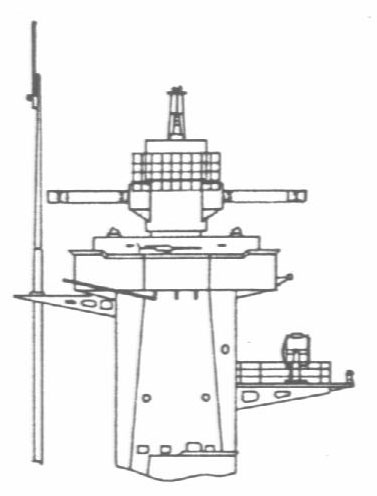
The foretop of Spee with the rangefinder tower topped by a radar hut for the prototype set FMG 39 (gO) - later designated FuMO 22 - and its 0.8m x 1.8m matress antenna; fitted in 1939.
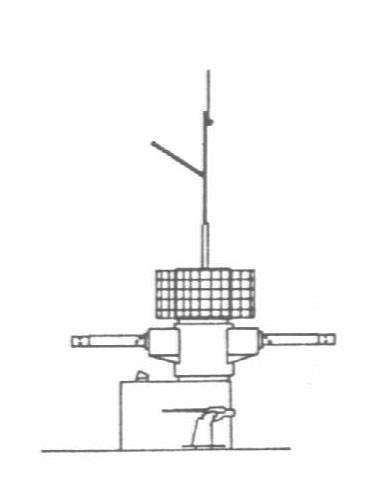
The after rangefinder of Scheer with the 2m x 4m antenna of the FuMO 27 set added in 1941.
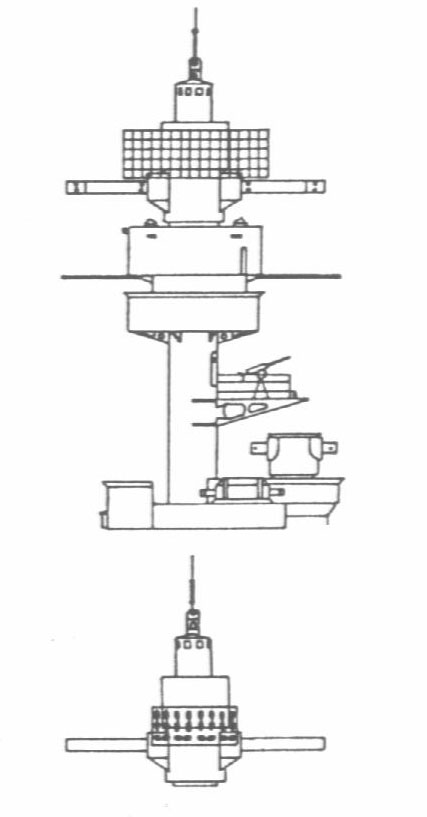
The foretop of Lützow with the radar hut and 2m x 6m antenna of FuMO 22 added above the rangefinder tower in 1939.
The lower drawing shows the Samos antenna for FuMB 4, added to the back of the tower in January 1942, and carried until March 1944. Note the battle-observers's post above the radar hut and that her foretop rangefinder is 2m higher above the waterline, than those of her sisters. Lützow was never fitted with radar on her after rangefinder tower.
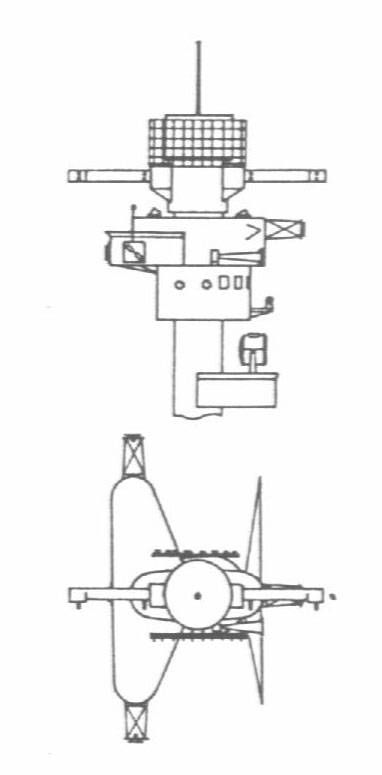
The forward conning tower of Scheer as modified in the summer of 1940. The 10m-rangefinder tower carries the radar hut and the antenna for the FuMO 27 which replaced the FuMO 22 (as shown in B) fitted on the original, Spee-type, bridge.
Note the absence of a battle-observer's post. She also carries four Sumatra antennas (foward aft and besides the tower), three being on lattice extensions. The passive Timor antenna was fitted on the back of the radar hut/rangefinder tower in 1942.
In November 1939 both these vessels were equipped with an 81.5cm (368MHz) FuMO 22 situated in an additional tower above the forward rangefinder tower. The 2m x 6m mattress antenna on the front of the tower rotated with the 10.5m rangefinders so the result from both instruments could be compared. During their stay at Brest in the summer 1941 they were fitted with a FuMO 27 on the after rangefinder tower and for their 'Channel dash' in 1942 both were probably equipped with a passive Palau antenna on a small frame at the back of their rangefinder tower, which thus operated in the reciprocal direction to the rangefinder and the active FuMO.
During a refit in Germany Scharnhorst received a new FuMO 26 or 27 set, with a 2m x 4m mattress antenna, under which was a smaller frame for the two rows of vertical and horizontal Timor dipoles serving the passive FuMB 4 Samos set.
To follow standard German practice there should also have been passive Sumatra antennas somewhere on the screen around the foretop rangefinder platform; however, they cannot be traced in any photography. It can also be assumed that they carried a small omni-directional round dipole FuMB 3 Bali, but the antenna for this set is to small to be clearly identified. It would have been fitted on the top of the foremast or on a yardarm.
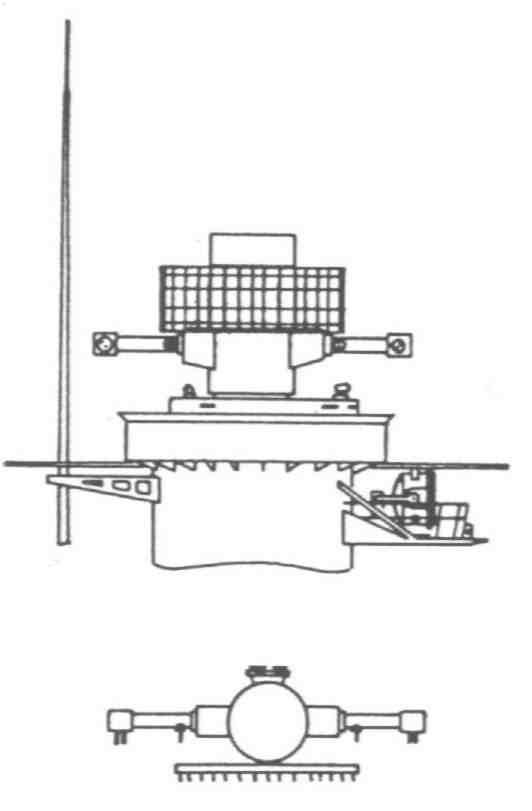
The FuMO 22 antenna (2m x 6m) fitted on a new tower above the foretop rangefinder tower in November 1939. The structure is crowned by an open battle-observer's post, Scharnhorst and Gneisenau being the only German capital ships to have this 'open' type. Also shown (in the plan view) are the butterfly-shaped Sumatra antennas probably fitted for the 'Channel dash' in 1942.
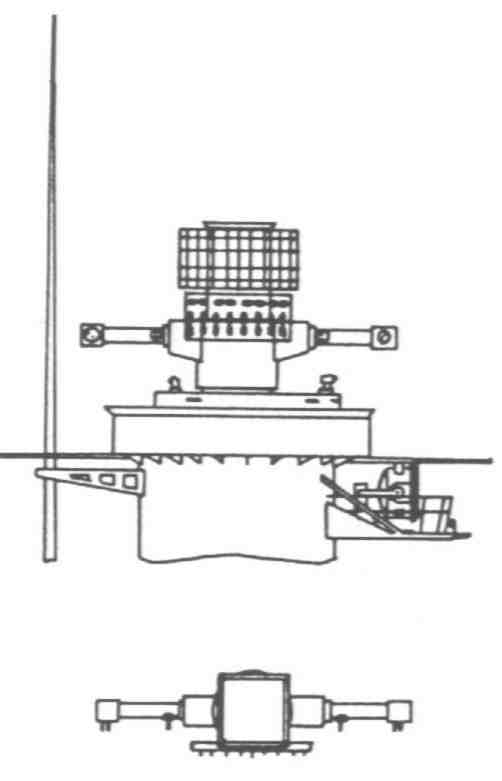
The foretop as modified in February 1942 with a square radar tower and the observer's post. The upper antenna is probably for FuMO 26 or 27 (2m x 6m) and the lower antenna the Timor frame for the FuMB 4 Samos.
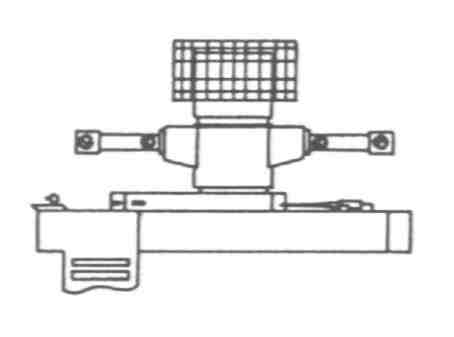
The after rangefinder tower with its vertically polarized FuMO 27 antenna (2m x 4m), fitted in the summer of 1941.
As the added weight of the radar tower resulted in a critical surplus load on the sensitive bearing engines of the rangefinder tower, both these battleships were fitted with enlarged towers, for all three gunnery rangefinders, housing both a FuMO 23 and the optical equipment. The installation of a fourth mattress antenna on the front of Bismarck's conning tower is the subject of controversy in German literature. The dimension of the structure appear to indicate that it had two rows of dipoles for active or passive detection, but the clarifying details are obscured in all photographs by a canvas cover.
The Tirpitz was re-equipped while she was based in Norway as part of the German standby force. Probably in January 1942 the foretop rangefinder tower was topped with an additional radar tower, carrying a FuMO 27 mattress antenna and a smaller frame, for the Timor antennas, above it. The sides and the rear of the radar tower were fitted with Sumatra antennas. In about the spring or summer of 1944 Tirpitz received an enlarged 3m x 6m mattress antenna, probably for FuMO 26. Careful examination of Tirpitz photographs reveals a small frame of a pole on top of the foretop tower, later moved to a bracket on the foremast to avoid interference with the FuMO 26. It is possible that this was either an experimental installation of FuMO 30 or the later standard frame for the Palau dipoles serving a FuMB 6. The addition of a trainable antenna frame to supplement the fixed antennas seems logical, but this would be the only appearance of a FuMO 30 on a German surface unit, it having originally been developed to submarines.
Again in the spring or summer of 1944, the third AA director, fitted just abaft the mainmast (German nickname 'Wackeltopf') was raised by 2m and equipped with an AA gunnery radar, probably Würzburg-C or Würzburg-D. As previously mentioned the Würzburg had originally been developed for the Luftwaffe, but it was later navalised for the German Navy's AA shore batteries under the following designation: FMG 39T/C (later FuSE 62C) Würzburg-C became the Navy FuMO 212, and FMG 39T/D (later FuSE 62D) Würzburg-D became the Navy FuMO 213. This reveals a fact that has not previously been published.
Tirpitz had the most sophisticated radar equipment of all the larger German surface units. However, without interviewing eye-witnesses we cannot know that these sets were not experimental, nor how effective they were under battle conditions. In this connection it would be most interesting to read British intelligence reports on the ship and to see Torstein Raaby's photographs of her. Torstein Raaby, who became famous after the war as member of Thor Heyerdahl's Kon Tiki expedition, was with the Norwegian resistance during the war and for ten months the spent much of his time on the top of the church tower of the Village of Alta watching the movements of the German capital ships lying in Kaa Fjord. He had a radio set, and camera with a telephoto lens, and his detailed reports to the British helped to ensure the ultimate destruction of the Tirpitz. As far as I know, his photographs have never been published, so where are they now?
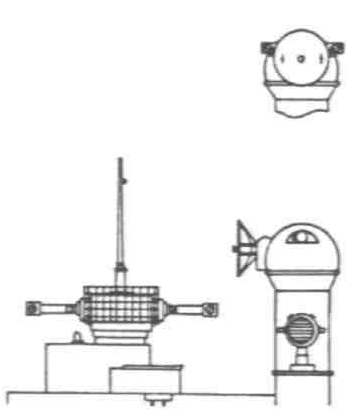
The after 10.5m rangefinder tower with FuMO 23 antennas (Tirpitz only 1940 - 12 Nov 1944).
The third 3-D, stabilized AA director with the 3m diameter parabolic dish antenna of FuMO 212 or 213. The base ring on the director was raised 2m in the spring/summer of 1944 (Tirpitz only).
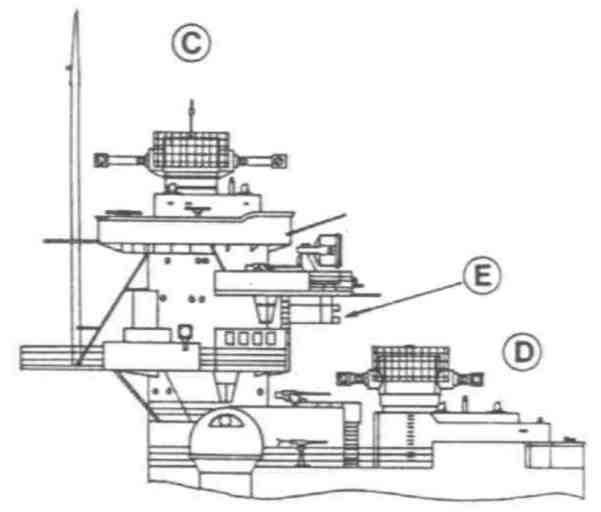
- Foretop 10.5m rangefinder tower and FuMO 23 antenna, 1940 - 12 Jan 1942.
- Forward 7m rangefinder tower and FuMO23 antenna, 1940 - 12 Nov 1944 (Tirpitz).
- Possible FuMO 21 dipoles in Bismarck, not definite proof for this assumption.

Foretop rangefinder tower crowned by an additional radar office, with FuMO 27 antenna, and topped by observer's post.
On the short pole on the roof of the radar hut is the Timor antenna of FuMO 4 Samos, January 1942 - Spring/Summer 1944.
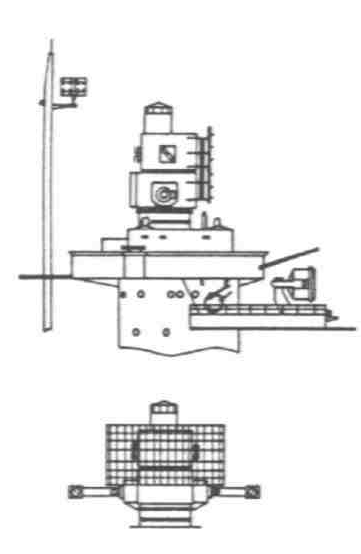
Foretop tower and radar hut supporting the large FuMO 26 antenna. FuMO 30 Hohentwiel placed on the foremast, Spring/Summer 1944 - 12 November 1944.
The most modern unit of this class, the short-lived Blücher, had her foretop rangefinder tower crowned by an additional radar tower carrying the 2m x 6m mattress of FuMO 22, but no battle-observer's post.
Admiral Hipper had similar equipment, but probably during her refit of late 1941 to early 1942, she received battle-observer's post atop the forward radar tower and a Timor frame on its rear. The after rangefinder was also topped by a radar tower for a FuMO27. There are astonishingly few photographs showing this ship after her recommissioning in March 1944, and little information is therefore available on her final radar fit. After February 1945 she docked at Deutsche Werke Kiel, where she was scuttled by her crew in May 1945.
Two postwar photographs taken during an examination by high ranking British officers immediately after the German capitulation, show that Admiral Hipper was to have been equipped with a FuMO 25 similar to Prinz Eugen (as picture 7.2), the scaffolding and the central revolving pole being clearly visible.
In her fnal configuration Prinz Eugen carried a huge 3m x 6m mattress for FuMO 26 on the face of her radar tower and an antenna on the foremast for the most sophisticated German radar set of the war - a FuMO 81 Berlin-S panoramic reconnaissance radar working on a wavelength of 6cm. The passive equipment consisted of the standard Sumatra, and the cone-shaped FuME 2 Wespe-G (2) atop the forward radar tower. It may be assumed that there were also Bali dipoles, but these are too small to be detected in photographs.
From August 1944 the Prinz Eugen carried a FuMO 25 (as fitted in destroyers) on her mainmast yardarm. Due to its position, this set could only be used on bearings from 35º to 325º, although it had 360º training.
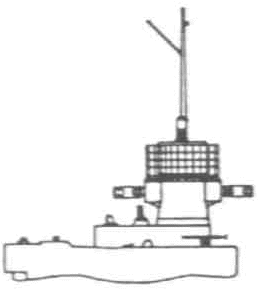
Hipper only: After 7m rangefinder tower, with radar office in the base, carrying antenna for FuMO27, end of 1941 - early 1942 to 3 May 1945.
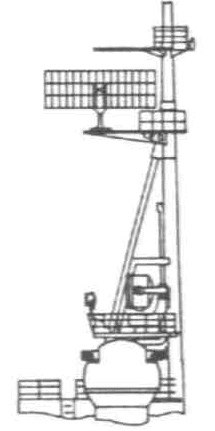
Hipper only: probably during her last refit (begun February 1945), FuMO 24/25 antennas added on mainmast.
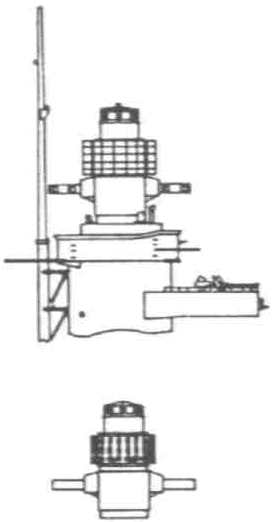
Hipper and Blücher: Foretop 7m rangefinder with radar office added in November 1939, for FuMO 27 on face of radar office and Timor frame on rear. Drawing shows latter configuration, with battle-observer's post that was added at the same time. During 1941/42 - May 1945 Hipper was probably re-equipped with FuMO 26 and other modern sets such as FuMO 63 and FuMO 81.
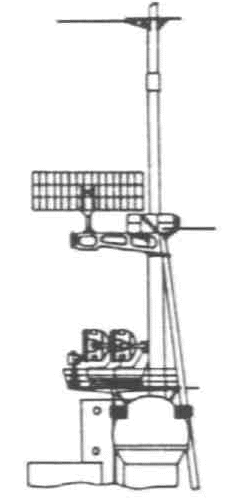
Prinz Eugen: FuMO 25 antenna on mainmast platform (training 35º to 325º). August 1944 - May 1945.
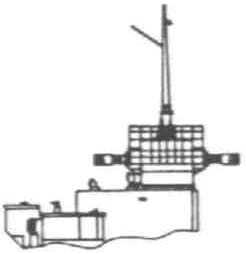
Prinz Eugen: After 7m rangefinder with antenna for FuMO 27, August 1940 - May 1945.
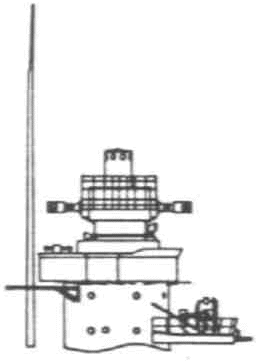
Prinz Eugen: Foretop 7m rangefinder with antenna for FuMO 27. The hut on the roof is an octagonal battle-observer's post, August 1940 - May 1945.
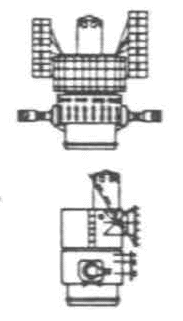
Prinz Eugen: Foretop tower, enlarged by addition of second level supporting the antenna for the improved FuMO 26 with sided 'owl ears' for hight-finding. Lower array is the Timor for the FuMB 4 Samos set, September 1942 - August 1944.
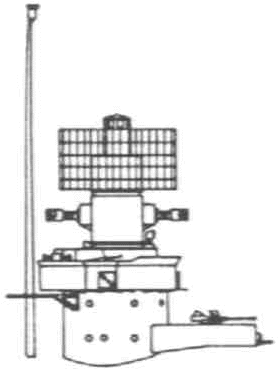
Prinz Eugen: Final configuration with FuMO 26 antenna on foretop tower and FuMO 81 Berlin-S on foremast head, August 1944 - May 1945.
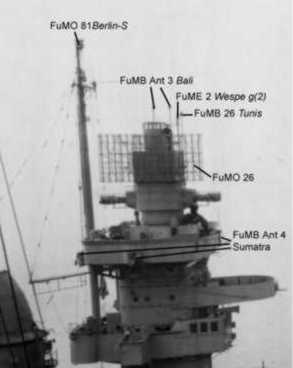
Picture of Prinz Eugen with detailed radar equipment.
None of the German light cruisers which took part in the assault on Norway had radar. Two of the three 'K' class cruisers were lost in this operation, so the only remaining modern light cruisers were Köln and Nürnberg. Leipzig's fighting potential having been so reduced by a torpedo hit, that she served as a cadet training ship for the rest of the war as did the obsolete Emden.
While Köln and Nürnberg served with the Norwegian stand-by-force, they were fitted with a FuMO 21, with 2m x 4m mattress antennas in place of the forward rangefinder.
In the summer of 1944 Nürnberg received a large FuMO 25 frame on one of the yardarms of the armored tower, above that, on a smaller yardarm was a rotating frame carrying two Palau dipoles. However, one photograph of Nürnberg indicates that earlier she had a FuMO 22 with a 2m x 4m mattress antenna, place on her prominent forward yardarm.
The flanks of the armored spotting top were surrounded by some five fixed Sumatra dipoles which remained in place when the Palau frame was installed later, only one Sumatra, bearing in the forward direction, being removed.
Leipzig was similarly equipped after her recommissioning in August 1943, only the form of the large outrigger and the position of the yardarm supporting the Palau frame being different.
As Köln was active until the end of the war, it may be assumed that she was modified to the same standards, but there are no photographs showing this.
As the only remaining active major German surface vessel in the latter stages of the war, Nürnberg was fitted with a fully trainable FuMO 63 Hohentwiel-K on the top of her mainmast, which had to be strengthened with tripod legs. In the last phase of the war Emden received a FuMO 25 in similar configuration.
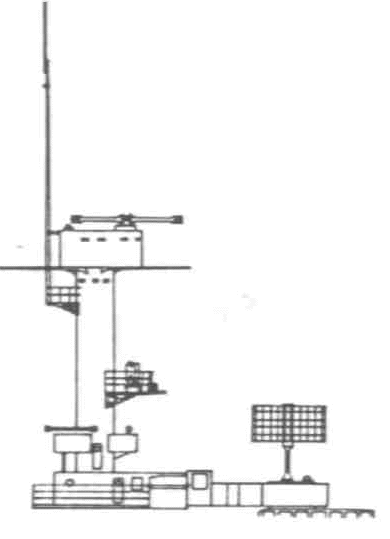
Köln's forward rangefinder replaced by FuMO 21 antenna (as fitted in destroyers) in the summer of 1941 or 1942; carried until 30 April 1945. Modification, similar to those in the FuMO 25 of Leipzig, is possible but uncertain.
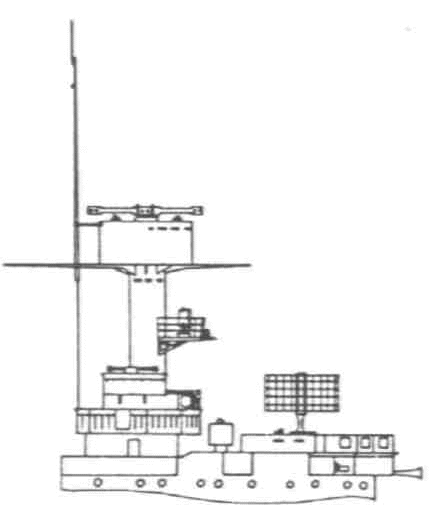
Nürnberg with forward rangefinder replaced by FuMO 21 antenna, summer 1941 - summer 1944.
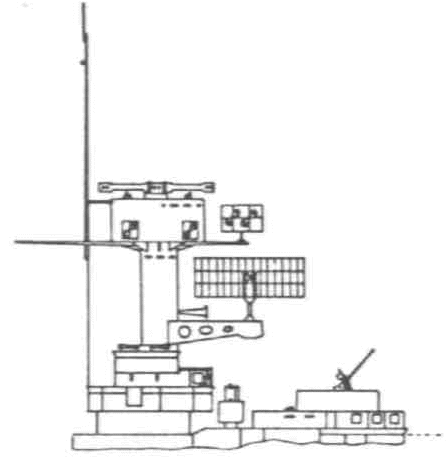
Nürnberg with a FuMO 24/25 antenna on a Prinz Eugen-type bracket, a FuMB 6 Palau antenna above and fixed Sumatra antennas on the spotting top, summer 1944 - May 1945.
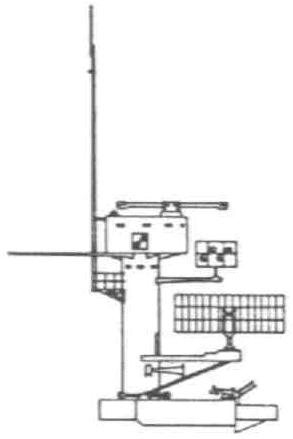
Leipzig after re-commissioning, 1 August 1943, with the large FuMO 24/25 antenna forward of her bridge tower and a FuMB 6 Palau above it.
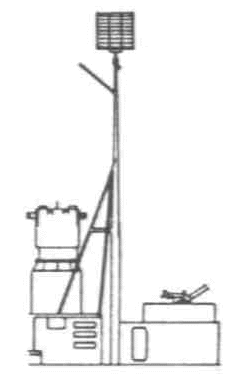
Nürnberg's mainmast with a FuMO 63 Hohentwiel-K at its head and tripod struts added for stiffness, Summer 1944 - May 1945.
During extensive refits in the last weeks of the war, the two old pre-dreadnought battleships Schleswig and Schleswig-Holstein were equipped with radar similar to that in Nürnberg and Leipzig: A FuMO 25 with a large 2m x 6m mattress on an outrigger and a smaller training Palau frame above.
Most larger auxiliaries, such as tenders of the Wilhelm Bauer class, the Gustav Nachtigal class and the Carl Peters received a standard FuMO 21.
The floating AA batteries Udine, Ariadne, Niobe and Arcona, some built on the hulks of First World War cruisers (e.g. the Gazelle class), were fitted with the AA fire control radars FuMO 212 or 213 Würzburg-C or -D.
The radar equipment of German destroyers followed a standard pattern, and only at the end of the war do we find some individual layouts. The first standard equipment was the FuMO 21 (Zerstörerdrehsäule) with a 2m x 4m mattress installed above a special radar-office between foremast and bridge. In earlier types, with their short bridges, the frame could not be trained over its full arc but all German destroyers were in any case limited to this bearing angle by the mast. From the summer of 1943 the improved FuMO 25, with 2m x 6m mattress, was introduced, and was first fitted in the older boats.
To fully train the frame a distinctive 'goal post' (Tormast) mast was developed, the later type having sufficient space around their radar office for this structure. From the summer of 1944 some boats were fitted with a FuMO 63 Hohentwiel-K in place of the after searchlight platform, and a FuMB 6 Palau on a yardarm of the foremast. The passive equipment consisted of four fixed Sumatra dipoles situated either around the forward searchlight sponson, or at the level of the tripod junction.
Postwar photographs show the usual variety of small passive antennas - the omni-directional round-dipole of FuMB 3 Bali, the conical IFF antenna of FuME 2 Wespe-G and the diagonal 9cm dipoles of the FuMB Tunis forward of a small cheese-type reflector. The location of these antennas varies, but as they were small and light they were usually fitted high on the foremast.
A most interesting system was developed for the type 1944 destroyer Z52. It consisted of an AA director, similar to US Navy types, fitted with the 1.5m parabolic dish antenna of a FuMO 231 Euklid. In next stage of development, it was planned to switch down the set to 3cm wavelength to become the Euklid-Z.
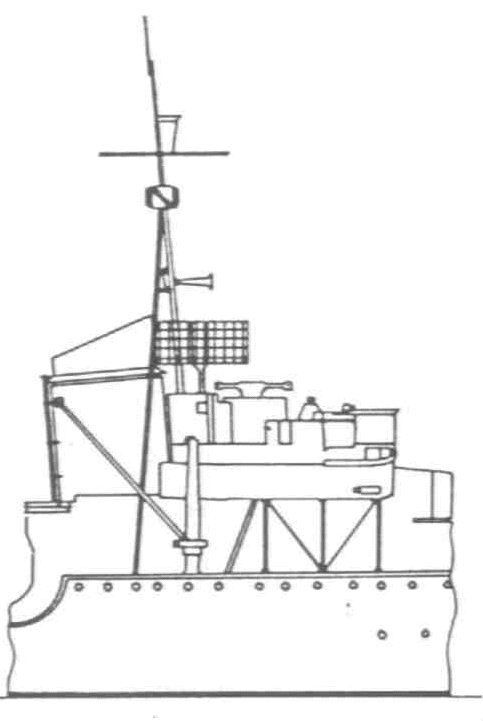
With FuMO 21 on the bridge and four fixed Sumatra antennas on the foremast on Z 5, 1941 - autumn 1943.
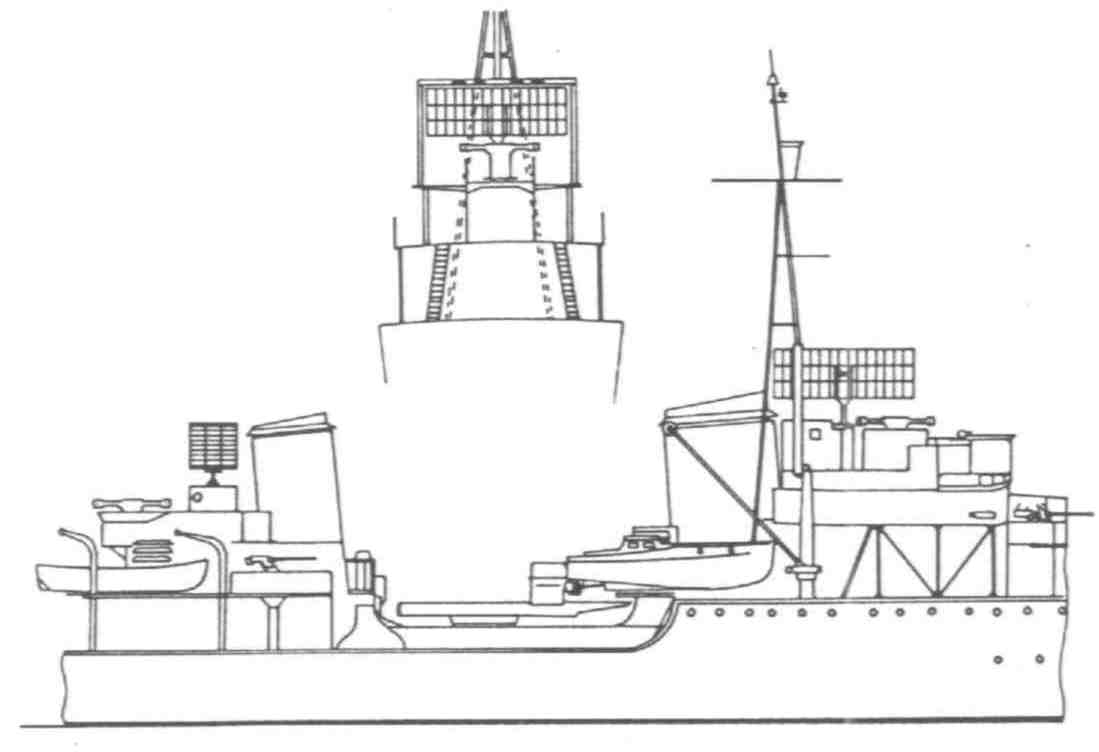
After searchlight platform removed and replaced by radar office and antenna for FuMO 63 Hohentwiel-K, mid 1944 - May 1945.
The distinctive goalpost mast (inset transverse view) for the FuMO 24/25 antenna at the rear of the bridge. At the foremast head is the conical antenna for FuME Wespe-G and on the spur below that round dipole of the Bali set, autumn 1943 - May 1945.
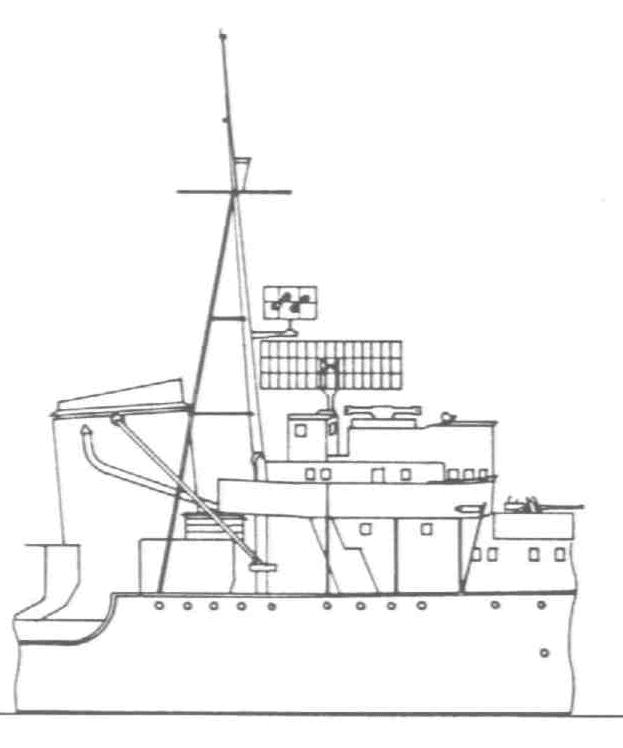
FuMO 24/25 radar on the bridge of Z25 with office moved sufficiently to allow full rotation of antenna. The FuMO 24/25 was replaced by a FuMO 21, with smaller 2m x 4m mattress antenna, in the same position 1944. The antenna on the foremast spur is a FuMB 6 Palau and that on the masthead is a FuMB 3 Bali.

The drawing shows the basic FuMO 21 onboard of Z38 which was carried until the end of the war and the four fixed Sumatra antennas fitted around the foremast searchlight platform and on the after edges of the mast struts. Note the differences from the 1963A type: curved forward funnel cap, height of the tripod struts and square forward edge to bridge wing.
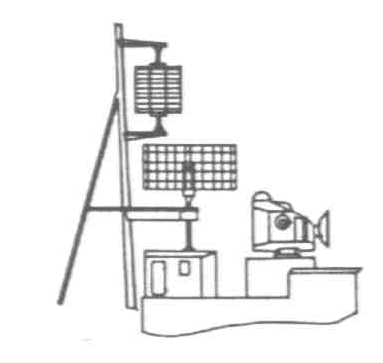
The uncompleted Z 52 would have had an impressive radar outfit. The gunnery radar FuMO 231 Euklid was to be combined with the 3D stabilized bridge director, carrying a 1.5m diameter parabolic dish antenna. The twin 128mm DP gun turrets would have been the first genuine radar controlled armament in a German warship. Other radar equipment is uncertain, the larger antenna having dimensions of 2m x 4m although FuMO 21 was by this time obsolete; the antenna on the foremast was either for a FuMO 63 Hohentwiel-K or a FuMB 6 Palau.
Originally the smaller types of German torpedo-boats had no radar equipment. As the FuMO 21 Zerstörerdrehsäule was too heavy for them, some of the 1935 type boats and the 1937 type boats received a FuMO 28 with fixed mattress; two fixed 2.3m x 3.8m antenna being installed on the tripod foremast (Picture 9.8).
The radar scanned by lobe-switching, but it was obviously an inferior system because, when the FuMO 63 Hohentwiel-K became available at the beginning of 1944, the surviving boats were fitted with two of these sets - one on the foremast and one on the mainmast. The same modification was made in the few surviving boats of the old 1923 and 1924 types. The passive equipment matched the contemporary standard in destroyers.
The larger boats of 1939 type received a FuMO 21, but limited arc of training. Two forms of outrigger were employed to support the 2m x 4m mattress antennas of this set. Although his class of ships numbered no less than 15 boats, which served throughout the war, there are surprisingly few photographs of them. One shows that at least one boat had her after searchlights replaced by a FuMO 63 Hohentwiel-K as in some destroyers.
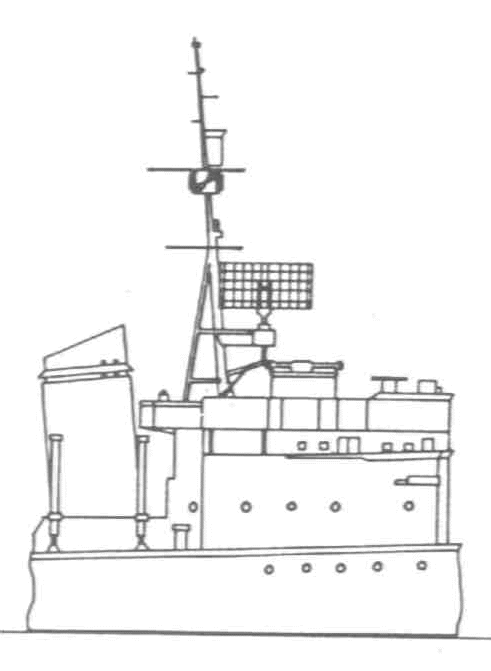
T22 - T36 with FuMO 21 antenna on a foremast spur, four fixed Sumatra dipoles under crow's nest and a FuMB 3 Bali antenna on the masthead.
As Germany was rather late in developing centimetric radar, it was not until the last weeks of the war a few 'small' sets became available. There is a photograph showing a minesweeper of the 1943 Type (M 801 series) with a FuMO 62 Hohentwiel-S.
The German S-Boats which mainly operated at night and had to navigate the difficult waters of the Channel, also requested radar sets. As the Luftwaffe replaced their nightfighter FuG 202 Liechtenstein-B/C with more modern units, the Navy took over the old sets, as they worked at high frequency, required only small antennas. It was navalised, largely by discarding the high-bearing tupe, and redesigned FuMO 71 Liechtenstein-B/C. An experimental set was installed aboard an S-Boat and, as the fixed array necessitated training aboard an the boat in order to detect a target, a rotating antenna (1.6m x 1.3m) was developed under the designation FuMO 72. However, this increased the silhouette of this particular experimental boat in such a way that it was always sighted first, consequently receiving the nickname 'grenade collector'.
Later a Vorpostenboot, the Vp 1107, was fitted with an experimental FuMO 72. As with all Luftwaffe sets, but unlike most of the Kriegsmarine sets, the Liechtenstein had vertical polarsation. As far as known, no German S-Boat received an operational radar set.
The increasing intensity of the 'microwave war' caused a steady re-equipment of all German submarines with detection sets which became more and more sophisticated. To detect the British ASV (air to surface vessel) radar all German submarines were equipped, from the summer of 1942, with 'Metox' detectors manufactured by the French firms Grandin and Sadir. The antenna was a simple wooden cross, nicknamed 'Biscay cross', which had to be turned by hand and withdrawn into the boat when diving. As the British switched to microwave radar in the spring of 1943, German submarines were attacked so often, usually without a chance to take countermeasures and sometimes on totally dark nights, that losses became catastrophic. German industry was, therefore, ordered to develop new radar emission detection receivers which resulted in the production of several sets (Naxos, Cypern I, Cypern II, etc.) which employed two interchangeable antenna systems serving two different purposes:
- The pressure-proof round dipole Bali for improved omni-directional reception
- The Palau antenna for direction finding, whose distinctive butterfly shaped antennas were situated at the rear side of the Hohentwiel frame
Although Germany was leading in this field in 1939 certain factors meant that German submarines could not use radar extensively for observation and detection purposes.
Firstly, German scientiests believed strongly, that it was impossible to bring down radar wavelength to the centimetre (VHF) band so all German sets, in the first half of the war, suffered form the bearing inaccuracies inherent with metric radar and served merely as navigation aids. Only after the Germans had examined a British H2O set, containing the revolutionary cavity megatron, were they able, by copying it, to cross the VHF barrier. By then it was too late to regain all the lost technological and scientific development of the previous years.
Secondly, the German Navy having overestimated the value of passive versus active detection, created a philosophy of 'radar silence' to avoid passive detection in the same way as 'radio silence' was intended to prevent signal interception and direction finding. This might also explain why the Navy had radar with vertically polarized transmission throughout the war; an arrangement which resulted in water surface disturbance of the radar signal ('grass'). In contrast, even the first Luftwaffe ASV detection sets had horizontal polarization to avoid this problem. Hence, nearly all German wartime naval radars had aerials with vertical dipoles.
Lastly, the radar antennas were fitted in such a way that they could not used while snorkelling so, although the U-boats had radar sets, they were outdated, largely silenced and, for most of the time, useless.
The first radar employed on U-boats was a submarine version of the standard German Seetakt (82cm wavelength, 386 megacycles). The FuMO 29 set had a 2x6 fixed dipole array fitted on the forward face of the conning tower while FuMO 30 had a small turnable frame aerial with only 2x4 dipoles. Results with these sets were unsatisfactory but the Luftwaffe which held more advanced views on radar than the Navy and was now the leading service in this field, had a better type, the FuMG 200 Hohentwiel (56cm wavelength, 556 megacycles). This set became the FuMO 61 Hohentwiel-U which employed a rectangular frame aerial (1m x 1,4m) carrying 4x6 dipoles.
Although German radar development was very promising in its early stages it was quickly overtaken by allied technology. One major reason for this was that the German Navy, which was the most conservative of the three services, did not realize the full potential of active radar, leaving the Allies in a favorable position to force the pace of the microwave war. The German Navy had decided that radar transmissions would provide a source from which an enemy could obtain a 'fix' on a ship's position, in the same way that direction-finders could be used to obtain a 'fix' on the source of a radio transmission. Extensive use of radar was therefore discouraged, a decision reinforced by the German belief in the superiority of their optical equipment. It is significant that young officers were taught absolutely nothing about radar and had to learn from scratch about the complex microwave war while on active service, in conditions where any fault could be fatal. It was not until March 1945 that German Naval Command issued Tactical order No 10 entitled Instruction for use of radar aboard surface units.
Thus the story of German naval radar in surface units is one of 'too lates'. The other services, especially the Luftwaffe, the Flak (AA) troops and even coast defense artillery, employed radar skillfully and extensively, while the Navy was tardy in proving information and training in new technology.
Knowledge of high-frequency radio emissions was therefore limited and the quality of the radar aboard German ships depended substantially on the personnel interest of the responsible radio officer. Only a few of these were electronic experts, by virtue of being enthusiastic, and even fewer had good contacts in the electronic industry, thus reducing their chances of improving sets in service. It is not surprising therefore that, under the rough conditions aboard a ship, the sensitive electronic equipment soon deteriorated and became faulty. Many surface units did not have their radar equipment recalibrated during the long periods of their careers! Thus sets became so unreliable that the commander refused to use them - an easy decision, when asked to hold strict radar silence whenever possible.
To counter the superior Allied radar technology, German surface vessels were fitted with more and more passive sets, the field becoming so extended that description of the German passive radar-sets, the Funkmess-Beobachtungsgeräte or FuMBs has been reserved for a separate article.
This article was published over 15 years ago in the now defunct British naval quarterly 'Warship'. Basically the content is still valid today, although some fine details, especially regarding equipment details in defined periods, are now obsolete as new literature has been published recently. This article produced a remarkable echo, as it was the first attempt to describe this widely unknown topic.
- E. Sieche, Vienna, September 1998
- Beaver, Paul: U-Boats in the Atlantic, Patrick Stephens, Cambridge 1979
- Beaver, Paul: German Capital Ships, Patrick Stephens, Cambridge, 1981
- Beaver, Paul: German Destroyers and Escorts, Cambridge, 1982
- Bekker, Cajus: Die versunkene Flotte, Gerhard Stalling, Oldenburg 1969
- Bekker, Cajus: Das große Bildbuch der Kriegsmarine, Gerhard Stalling, Oldenburg 1972
- Bekker, Cajus: Augen durch Nacht und Nebel, die Radar-Story, Gerhard Stalling, Oldenburg 1962
- Breyer, Siegfried/Koop, Gerhard: Von der Emden zur Tirpitz, 2 volumes, Wehr&Wissen, Bonn 1981
- Brown, David: Tirpitz, the floating Fortress, Arms & Armour Press, London 1977
- Friedmann, Norman: Naval Radar, Conway Maritime Press, London 1981
- Giessler, Helmut. Der Marine-Nachrichten und -Ortungsdienst, Lehmann, Munich 1971
- Harnack, Wolfgang: Zerstörer unter deutscher Flagge, Koehlers, Herford 1978
- Herzog, Bodo: Die deutsche Kriegsmarine im Kampf, eine Dokumentation in Bildern, Podzun, Dorheim 1975
- Herzog, Bodo/Elfrath, Ulrich: Schlachtschiff Bismarck, ein Bericht in Bildern und Dokumenten, Podzun, Dorheim 1975
- Humble, Richard: Hitler's High Seas Fleet, Pan/Ballantine, 1971
- Jones, R V: Most Secret War, Hamish Hamilton, London 1978
- Mallman-Showel, Jak P: The German Navy in World War Two, Arms & Armour, London 1979
- Niehaus, Werner: Die Radar-Schlacht, Motorbuch, Stuttgart 1977
- Prager, Hans-Georg: Panzerschiff Deutschland, Schwerer Kreuzer Lützow, Koehlers, Herford 1981
- Price, Alfred: Instruments of Darkness, W Kimber & Co, London 1967
- Thomas, Egbert: Torpedoboote und Zerstörer, Gerhard Stalling, Oldbenburg 1970
- Schmalenbach, Paul: Kreuzer Prinz Eugen, Koehlers, Herford 1978
"German Naval Radar to 1945" is copyrighted by the author, Erwin F. Sieche of Vienna. It originally appeared in Warship volumes 21 and 22 in 1982. This article may not be reproduced without the prior consent of the author.
I am indebted to Dipl.-Ing. Heinz-Gerhard Schöck who transcribed this article and permitted it to be used at this website.
